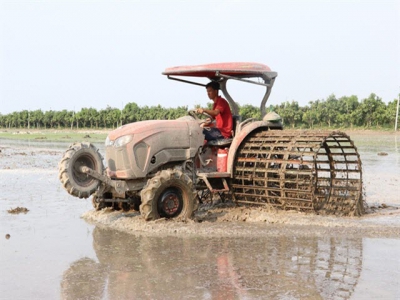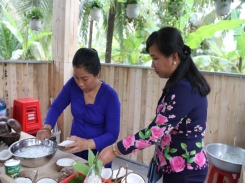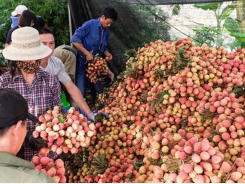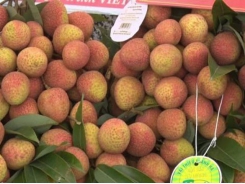Rice farms in Đồng Tháp fully mechanised

ĐỒNG THÁP — Farmers in the Cửu Long (Mekong) Delta province of Đồng Tháp are using agricultural machines for all rice cultivation processes on nearly 100 per cent of rice farms.
A machine is used to plow a rice field in Đồng Tháp Province. – VNA/VNS Photo Nguyễn Văn Trí
The machines are used to plow rice fields, transplant rice seedlings, provide fertiliser, spray pesticides, and harvest paddy.
Mechanisation reduces production costs and increases production efficiency and profits for farmers, the province’s Department of Agriculture and Rural Development said.
Nguyễn Văn Út, who owns a 2ha rice field in Tháp Mười District’s Láng Biển Commune, uses a machine to transplant rice seedlings. It offers a yield of 1 tonne per hectare more than manual seed sowing, he said.
The number of seeds used to grow seedlings is only 60 kilogrammes per hectare compared to 180 – 120 kilogramme per hectare sown manually.
Rice seedlings transplanted by machines develop well, have fewer diseases, and are resistant to wind and rain and do not easily fall down, and are easy to harvest, he said.
The profit from using machines for transplanting rice seedlings is about VNĐ10 million (US$430) per hectare more than from manual sowing.
Combine machines used to transplant rice seedlings and fertilise crops at the same time save labour costs and time.
In Tháp Mười, Cao Lãnh and Tam Nông districts, many farmers use drones to spray pesticides on rice fields.
The drones reduce the use of pesticides by 20 – 30 per cent and are 10 -15 times faster compared to traditional spraying methods. It protects farmers’ health as well.
Smart rice farming methods and smart equipment are also used to improve yields and cut costs.
This year, Mỹ Đông 2 and Thắng Lợi co-operatives in Tháp Mười District plan to grow a total of 175ha of rice using smart rice farming.
Nguyễn Thanh Mỹ, chairman of the Mỹ Lan Group, said smart rice farming reduces production costs by nearly 50 per cent, increases yields by 10 per cent, and reduces greenhouse gas emissions by 50 per cent compared to traditional rice farming models.
Agriculture co-operatives and co-operative groups have developed organic rice farming in Hồng Ngự, Tam Nông, Thanh Bình and Tháp Mười districts as it offers higher profits and guaranteed outlets for their rice, and is environmentally friendly.
Higher profits
Đồng Tháp plans to cultivate 490,000ha of rice this year compared to 521,000ha last year since authorities have encouraged farmers to grow high-value crops on unproductive rice fields.
The province, the first in the country chosen by the central Government to restructure agricultural production, has achieved positive results in rice and other crop cultivation in recent years.
Farmers in the province grew 200,000ha of rice in the 2019-20 winter – spring crop and harvested 1.4 million tonnes of paddy and earned a profit of VNĐ18 – 20 million ($770 - 860) per hectare, VNĐ5 million higher per ha than a year earlier.
In the ongoing summer - autumn crop, farmers sowed more than 180,000ha of rice and have harvested more than 43,400ha, with an average yield of six tonnes per hectare so far.
Farmers have seen a profit of VNĐ30 million ($1,290) per hectare in the summer – autumn rice.
Nguyễn Phước Thiện, director of the department, said farmers have achieved good results in the summer – autumn crop by using Vietnamese good agricultural practices (VietGAP) and integrated pest management.
The "one must and five reductions" method has required farmers to use certified seeds, and reduce seedlings, plant protection chemicals, nitrogen fertilisers, irrigation, and post-harvest losses.
Under the encouragement of province authorities, farmers have also switched to more high-quality rice varieties to meet export demand.
The province is encouraging farmers to expand the cultivation of two new rice varieties from Thailand – RD 71 and AD 61 – as they have a short maturity period of 88 -100 days, have high yield and high quality, and are suited to the province’s natural conditions.
Lê Thị Hoa of the province’s High-Tech Agriculture Application Centre said the two varieties have been planted on a pilot farm in Hồng Ngự and Tân Hồng districts.
“Cultivation results show that they have high quality, a short maturity period, and a high yield of 6 – 7 tonnes per hectare,” she said.
About 60 per cent of the province’s rice growing areas are planted with high-quality rice varieties, according to the department.
Related news
Tools

Phối trộn thức ăn chăn nuôi

Pha dung dịch thủy canh

Định mức cho tôm ăn

Phối trộn phân bón NPK

Xác định tỷ lệ tôm sống

Chuyển đổi đơn vị phân bón

Xác định công suất sục khí

Chuyển đổi đơn vị tôm

Tính diện tích nhà kính

Tính thể tích ao




 Gia Lai to have $44m hi-tech agricultural zone
Gia Lai to have $44m hi-tech agricultural zone  Hải Dương exports first lychees to Japan
Hải Dương exports first lychees to Japan